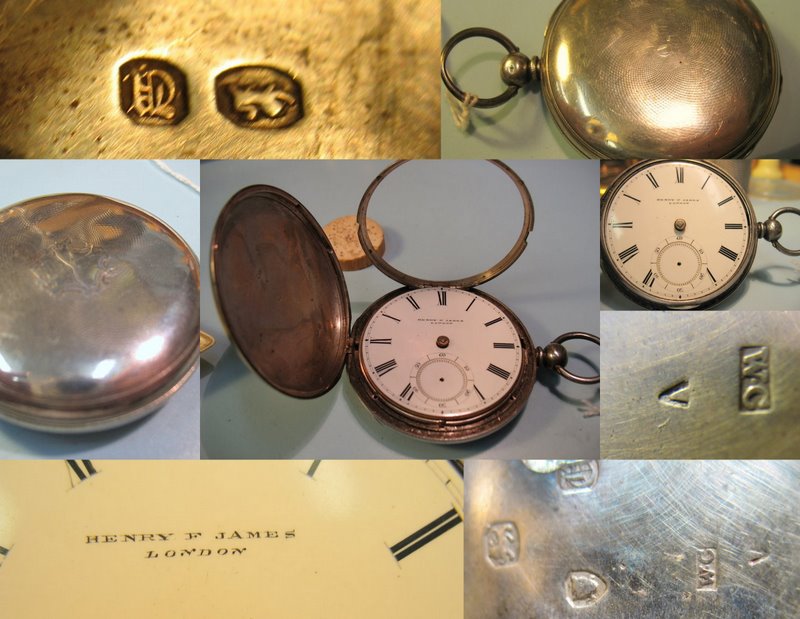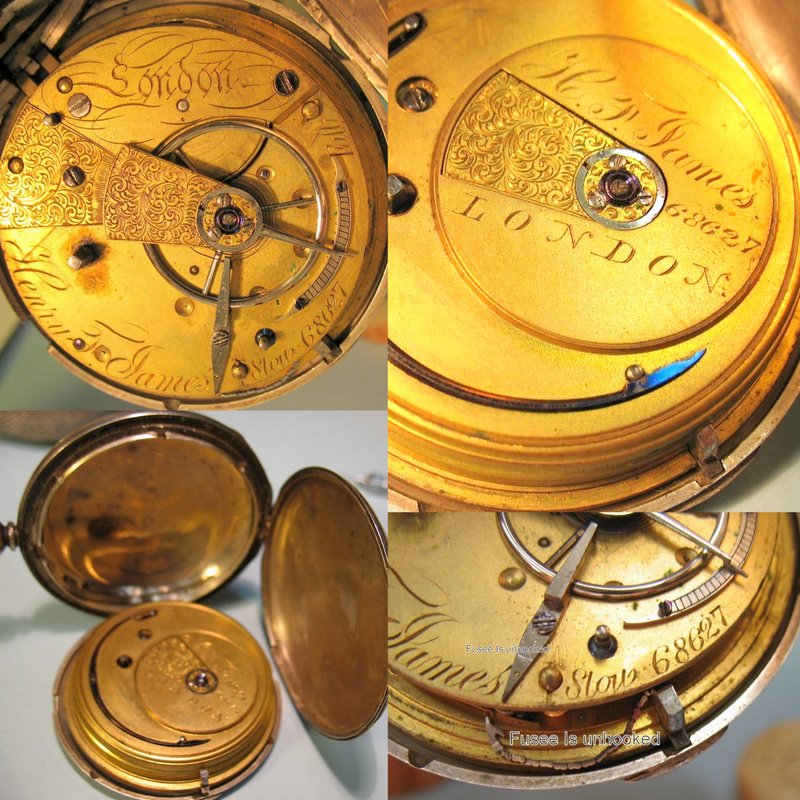
| WWT Shows | CLICK TO: Join and Support Internet Horology Club 185™ | IHC185™ Forums |

|
• Check Out Our... • • TWO Book Offer! • |
Welcome Aboard IHC185™  Internet Horology Club 185
Internet Horology Club 185  IHC185™ Discussion Site Main Page
IHC185™ Discussion Site Main Page  Horological Discussions, Questions and Answers
Horological Discussions, Questions and Answers  European Pocket Watch Forum
European Pocket Watch Forum  Henry F James, London Fusee Details?
Henry F James, London Fusee Details?
 Internet Horology Club 185
Internet Horology Club 185  IHC185™ Discussion Site Main Page
IHC185™ Discussion Site Main Page  Horological Discussions, Questions and Answers
Horological Discussions, Questions and Answers  European Pocket Watch Forum
European Pocket Watch Forum  Henry F James, London Fusee Details?
Henry F James, London Fusee Details?Go  | New Topic  | Find-Or-Search  | Notify  | Tools  | Reply to Post  |  |
| IHC Life Member |
An anonymous but close friend asked me to look at this watch. He did not try to (luckily) open it so I looked at it.  | ||
|
| IHC Life Member |
The case was hand-fitted to the movement and a very clever Sizing ring was used for that fitment and also to allow a "swing-out movment co-hinged with the crystal bezel for service. This construction allows for a slim 15 mm case that with it's 56 mm outside diameter gave a "dandy" appearance. As the Fusee Chain is loose, but the loose end still has the hook, I am not sure if there is anything really wrong with it. While it is not heavily jeweled, it does have huge a faceted Anybody know if this is anyting more than a "trade grade" watch?  | |||
|
David Your friend owns a nice watch and he did well not to try to open it himself, The first time you open a swing-out is always a risk when you don't know how to touch. The hallmarks read silver, London assay, 1854, 1855 (gothic 'T' and 'U', hard to read); Case maker may be 'William Chinnery, London, reg. 1825. I found no information on 'Henry F. James', but some examples of his work (pictures of movements) They show some variations of the same movement type with more jewels or with a screwed compensation balance). In the shown watch he did what he had to do to make a good 'working horse'; no 'extras' but the diamond cap stone. With knowing, skill and tradition he made a nice slim movement. The whole watch seems to be in good condition. I like a 'simple' watch in good condition more than a 'fine' one with chips and hairlines. The labeled dial is the icing on the cake. I think the mainspring is a bit of 'set' and the 'lameness' had overcome the 'pre-tension' which normaly prevents the chain from unhooking. Cleaning and a set of hands may be all she needs. Regards, Gerald | ||||
|
David, I've no trace of James in any of my books, but Tom or another member may have him in the latest edition of Loomes Watchmakers of the World. Gerald got the year of assay spot on! I've got one or two other casemakers listed using that shield, will add them later. Certainly no 'Trade Grade' watch your friend has there! With the maker's name on the dial and movement in the 1800's, James would almost certainly have been a 'Master' watchmaker having been awarded the 'Freedom of the Clockmaker's Company'. In London, he would likely as not have had a ready clientelle for his watches. I doubt he would have entertained the thought of 'Trade work' for a second. In that era, it was actually illegal for watch or clockmakers to engrave their names into movements unless they were 'Masters'. It was an offence punishable by imprisonment otherwise! To add to Gerald's thoughts on the movement, I'd take a look behind the dial and see if the ratchet wheel is still in place and locked by the click. Often these get disturbed by cack handed 'repairers' who then suffer the indignity of the thing twanging off and releasing the fusee pre-load - often with catastrophic results if it was fully wound! The mainspring could also have broken - possibly when the watch was partially wound! A fully wound mainspring breaking in a fusee almost invariably destroys the barrel hook or breaks the chain. Broken or bent train wheel teeth are also a consequence, but it would have to be stripped to check for unseen damage. Another possibility, is that someone doing a clean on it, didn't discover the knack of winding the chain back onto the barrel - they slip off easily and can be a pig to untangle and get back on again. Usually it means taking the barrel out again at least - or splitting the plates again. Very many give up! (and stick 'em on eBay)! As regards the diamond endstone, I'd have been more surprised to see a London made watch Without one! Otherwise, a handmade watch created by a London Master watchmaker and well worth restoring! Best regards John | ||||
|
| IHC Life Member Site Moderator |
I had checked the newest edition when David posted this but I couldn't find the maker in it either. Tom | |||
|
| Powered by Social Strata |
| Your request is being processed... |
|
Welcome Aboard IHC185™  Internet Horology Club 185
Internet Horology Club 185  IHC185™ Discussion Site Main Page
IHC185™ Discussion Site Main Page  Horological Discussions, Questions and Answers
Horological Discussions, Questions and Answers  European Pocket Watch Forum
European Pocket Watch Forum  Henry F James, London Fusee Details?
Henry F James, London Fusee Details?
 Internet Horology Club 185
Internet Horology Club 185  IHC185™ Discussion Site Main Page
IHC185™ Discussion Site Main Page  Horological Discussions, Questions and Answers
Horological Discussions, Questions and Answers  European Pocket Watch Forum
European Pocket Watch Forum  Henry F James, London Fusee Details?
Henry F James, London Fusee Details?©2002-2025 Internet Horology Club 185™ - Lindell V. Riddle President - All Rights Reserved Worldwide

